Pachycostasaurus
Pachycostasaurus (meaning 'thick - ribbed lizard') is an extinct Pliosauroid from the Oxford Clay formation of Peterborough, England.
| Pachycostasaurus Temporal range: Middle Jurassic | |
|---|---|
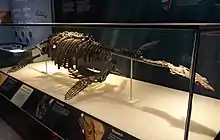 | |
| Holotype fossil, Peterborough Museum | |
| Scientific classification | |
| Kingdom: | Animalia |
| Phylum: | Chordata |
| Class: | Reptilia |
| Superorder: | †Sauropterygia |
| Order: | †Plesiosauria |
| Family: | †Pliosauridae |
| Genus: | †Pachycostasaurus Cruickshank et al., 1996 |
| Species: | †P. dawni |
| Binomial name | |
| †Pachycostasaurus dawni Cruickshank et al., 1996 | |
Description
The type species, P. dawni, is represented by a single near complete specimen (PETMG R338) which was approximately 3.1 metres in length. It had a robust barrel shaped torso, a relatively short neck and small flippers, indicating that it was not an agile swimmer.[1]
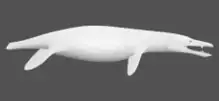
The holotypic specimen possessed five stout and conical tooth pairs on the mandibular symphysis (the length of which is a clear characteristic of the genus in comparison to other contemporary Pliosaurids such as Simolestes and Liopleurodon). Its head was about 20% of overall body length, small for most Pliosaurids. The specimen had a cervical vertebral count of at least 13, these vertebrae having shortened centra and an enlarged neural canal, which were not heavily ossified except in the region of the neural spine (the neural spines themselves were not fused to the centra, which suggests that the specimen was not fully grown; however, this could also be a Paedomorphic trait.[2]) The cervical ribs were shortened and thickened, as well as double headed.
The pectoral centra of the specimen are triangular in outline, and the dorsal vertebral centra are heavily ossified, with indistinct subcentral foramina and flat anterior and posterior faces. The anterior and posterior Zygapophyses on the dorsal vertebrae are reduced, however the neural spines thickened, with midline anterior and posterior excavations. The dorsal ribs, as well as the gastralia, are thickened and pachyostotic (a characteristic of the genus) with concave heads, a round cross-section and a ‘sausage-like’ profile. Based on histological sections taken of the pachyostotic elements, it was determined that the bones are osteosclerotic as well (combined, represents the condition pachyosteosclerosis). This is one of the main characteristics of the genus. It has been suggested that even though the holotypic individual appears to be a juvenile or sub-adult, its age is probably not solely responsible for these unusual bone structures.[3]
The humeri of Pachycostasaurus are short, small compared to its body size, and lightly constructed.[1]
Palaeobiology
Pachycostasaurus was most probably a benthic predator (it possessed sharp, robust, conical teeth, circular in cross-section and heavily striated, but lacking prominent carinae). The relative size and shape of the teeth Indicate a diet ranging from soft teuthoids, such as belemnites, to bony fish, and perhaps some of the larger reptiles. Pachycostasaurus has a lightly constructed skull, a short, rather weak jaw symphysis, and ventral ballast for stability which would have resisted roll. Thus it is doubtful if Pachycostasaurus was a twist feeder like other contemporary pliosaurids. Cruickshank et al. suggested that the rarity of the animal in the formation may suggest that Pachycostasaurus was allochthonous, its normal habitat being a coastal or even fresh water environment, or on the other hand a deep water environment.
Pachycostasaurus was probably important in its food chain, as it would have transferred resources from the benthic food web to the surface food web as it came up to breathe.
References
- A. R. I. Cruickshank, D. M. Martill, and L. F. Noe. 1996. A pliosaur (Reptilia, Sauropterygia) exhibiting pachyostosis from the Middle Jurassic of England. Journal of the Geological Society of London 153:873-879
- Araujo, Ricardo. (2015). New aristonectine elasmosaurid plesiosaur specimens from the Early Maastrichtian of Angola and comments on paedomorphism in plesiosaurs. Geologie en Mijnbouw. FirstView. 10.1017/njg.2014.43.
- Street, Hallie P. "A study of the morphology of Tatenectes laramiensis, a cryptocleidoid plesiosaur from the Sundance Formation (Wyoming, USA)." (2009).
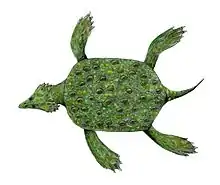

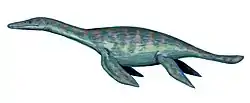

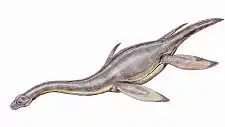
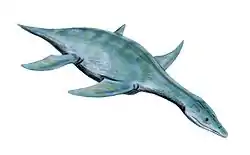
.png.webp)